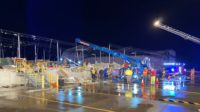Safety
OSHA Ends Amazon Warehouse Collapse Probe With No Citations
No building-related issues cited by agency in Edwardsville, Ill., tornado collapse investigation

The partial collapse of an Amazon warehouse in Edwardsville, Ill., on Dec. 10, 2021 is at the heart of a lawsuit against the online retailer and several firms involved in the design and construction of the building.
Photo courtesy of West County EMS & Fire Protection District
The US Occupational Safety and Health Administration has completed its investigation into the partial collapse of an Amazon.com Inc. warehouse in Edwardsvlle, Ill. without citing the online retailer or raising any concerns with the design or construction of the building. Six people were killed after a tornado hit the building on Dec. 10.
OSHA opted to issue hazard alert letters April 26 to Amazon and the delivery contractors who employed the workers, recommending that they improve their severe weather safety procedures. The agency noted that Amazon’s plans meet minimum federal safety guidelines for storm sheltering.
OSHA’s action comes in the midst of a lawsuit filed by the family of one worker killed in the collapse that accuses Amazon of failing to have an appropriate emergency action plan for severe storms, or refuge for workers in the building. It also names the general contractor of the warehouse, as well as several involved design and engineering firms, as defendants.
As ENR previously reported, an attorney for the family pointed to a report written by a Missouri fire marshal who responded to the collapse as a FEMA-trained structures specialist to raise questions about its design and construction. The contractor, Contegra Construction, has disputed the report, saying it appeared the fire marshal was unaware of the specific techniques used in the construction. The firm says those techniques meet building code requirements.
Attorneys for the family did not immediately respond to an inquiry about any implications that OSHA’s action may mean for the case. An attorney for Contegra declined to comment.
OSHA’s letter made no mention of any building-related issues. Agency investigators checked local building codes and verified that the warehouse had been issued an occupancy permit, says agency spokesperson Rhonda Burke. Building integrity issues are generally addressed by the local and state agencies that enforce building codes, she adds. There are no OSHA standards dealing specifically with completed buildings.
In cases where there is no specific OSHA standard, the agency can turn to the General Duty Clause of the Occupational Safety and Health Act, which holds employers responsible for providing a safe workplace. To use the clause in citing an employer, the agency must meet requirements establishing that there is a serious hazard and that there must be a feasible way the employer can do something about it, says Jordan Barab, a former OSHA deputy assistant secretary.
Most challenging, OSHA must also be able to show there is a recognized hazard, he says. That may come from direct acknowledgement by the employer itself, or by others such as a union that documented the hazard or industry group standards which recommend against a particular practice.
“If OSHA were to find documentation saying that you should not construct a building in the manner anywhere where winds over X miles per hour can be expected, and Amazon had gone ahead and done it anyway, that could have established that there was actual recognition that building such a building in a tornado zone was a recognized hazard and the employer should have known that,” Barab says. “But absent any industry guidelines or practices like that, OSHA is going to have a hard time establishing that there is recognition of the hazard.”
OSHA also has no severe weather standards. However, it does have recommendations for severe weather emergency plans under the General Duty Clause. The hazard alert letter recommends three areas where OSHA says Amazon could improve safety at the Edwardsville warehouse, including ensuring that all employees are trained and participate in emergency weather drills. Amazon should also include site-specific information in severe-weather emergency plans, and ensure those plans clearly identify all audible warning devices and their locations.
“These tragic deaths have sparked discussions nationwide on the vital need for comprehensive workplace emergency plans,” William Donovan, OSHA's Chicago-based regional administrator, said in a statement. “Employers should reevaluate their emergency plans for the safest shelter-in-place locations and prepare before an emergency to ensure workers know where to go and how to keep themselves safe in the event of a disaster.”
Amazon spokesperson Kelly Nantel said the company’s buildings have emergency plans that identify exit routes and shelter areas, and that employees receive emergency response training.
“OSHA’s investigation did not find any violations or causes for citations, but we’re constantly looking to innovate and improve our safety measures and have already begun conducting additional safety and emergency preparedness drills at our sites and will carefully consider any OSHA recommendation that we have not already,” Nantel said in a statement.



